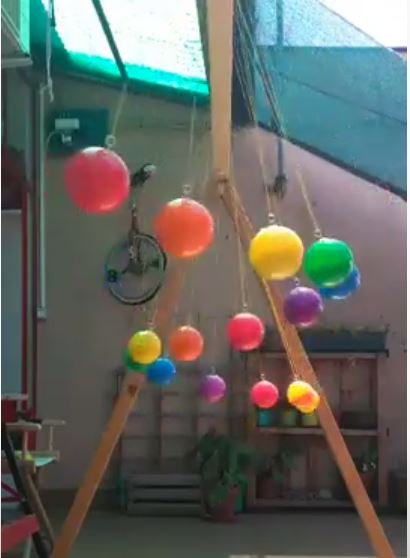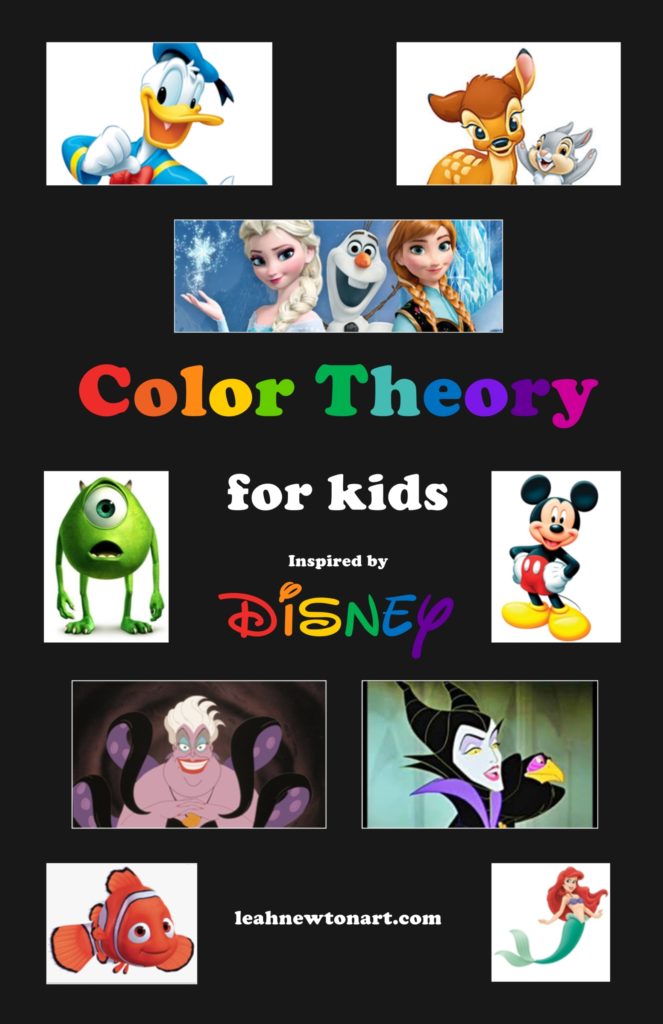In this magic color pendulum, rainbow colored balls swing through the air creating Color Theory enchantment. This project covers Common Core Standards for Science for grades K-8 which can be found at the end of the lesson.

Grade Level
Kindergarten, 1st, 2nd, 3rd, and 4th, 5th, 6th, 7th, 8th Grade
Objective
In this Magic Color Pendulum art lesson, students will identify color theory groups. Students discover the rhythm in a pendulum wave and how it is created. Then can even make one in their own home!
Time
1 – 60 min lesson
Materials
- Pencils
- Copy paper
This is the main video of the pendulum with color theory connections (I could not find the original owners of the video): Click Here
Inspiration/Artist
I was inspired to make this project after I saw this Youtube video: Click Here
Instruction with Questions
Day 1
Here is a fun science art connection! These balls are all hanging from the wooden beam. As they swing, they will naturally create groups.
You can use this as an introduction to color theory. Have students watch the video and tell you what they witnessed. Have them watch it again and document what groups they saw forming.
Or, use this as a review and use the same format. Both ways are great learning tools for engaging their brains. Here are a couple of more resources that can extend this lesson and connect with science.
Use this Color Theory for kids inspired by Disney PowerPoint Presentation: Click Here

This is the main video of the pendulum with color theory connections (I could not find the original owners of the video): Click Here
As students watch the video, have them look for magical groupings.
Primary colors – red, yellow, blue
And
Secondary colors – orange, green, purple
Warm (red, orange, yellow)
And
Cool (green, blue, purple)
Complimentary colors –
Red & Green (think Christmas)
Blue & Orange (think Halloween)
Purple & Yellow (think Easter)
Watch as the colorful balls on the pendulum unravel. After they create a variety of shapes, they finally return to the way they began.
See if you can find these combinations in your home, sports teams, Disney characters or superheroes, etc. Have students make lists for each color grouping.
Check out this additional video about how a pendulum works: Click Here
Sand pendulums – Lissajous patterns – part one // Homemade Science with Bruce Yeany
Here is a great directive on how to make a pendulum with kids: Click Here
Finally
Students create their own pendulum at home. This can be done using a variety of simple things found around their homes. There are many ideas on Pinterest and Google. Maybe they make theirs using a marble or salt or drip painting. You could even introduce them to Jackson Pollock and his drip painting technique!
www.hellowonderful.co/post/pendulum-painting-with-kids/

Common Core Standards
Kindergarten
Physical Sciences
1. Properties of materials can be observed, measured, and predicted
a. Students know objects can be described in terms of the materials they are made of and their physical properties
Investigation and Experimentation
4. Scientific progress is made by asking meaningful questions and conducting careful investigations. Students will:
d. Compare and sort common objects by one physical attribute
e. Communicate observations orally and through drawings.
1st Grade – Science
Investigation and Experimentation
4. Students will:
b. Record observations and data with pictures, numbers, or written statements.
d. Describe the relative position of objects by using two references
2nd Grade – Science
Physical Sciences
1. The motion of objects can be observed and measured. As a basis for understanding this concept:
a. Students know the position of an object can be described by locating it in relation to another object
b. Students know an object’s motion can be described by recording the change in position of the object over time.
c. Students know the way to change how something is moving is by giving it a push or a pull. The size of the change is related to the strength, or the amount of force, of the push or pull.
d. Students know tools and machines are used to apply pushes and pulls (forces) to make things move.
e. Students know objects fall to the ground
Investigation and Experimentation
4. Students will:
a. Make predictions based on observed patterns and not random guessing.
b. Measure length, weight, temperature, and liquid volume with appropriate tools and express those measurements in standard metric system units.
c. Compare and sort common objects according to two or more physical attributes.
d. Write or draw descriptions of a sequence of steps, events, and observations.
g. Follow oral instructions for a scientific investigation.
3rd Grade – Science
Investigation and Experimentation
5. Students will:
a. Repeat observations to improve accuracy
b. Differentiate evidence from opinion
c. Use numerical data in describing and comparing objects, events, and measurements.
d. Predict the outcome of a simple investigation and compare the result with the prediction.
e. Collect data in an investigation and analyze those data to develop a logical conclusion.
4th Grade – Science
Investigation and Experimentation
6. Scientific progress is made by asking meaningful questions and conducting careful investigations. Students will:
a. Differentiate observation from inference (interpretation) and know scientists’ explanations come partly from what they observe and partly from how they interpret their observations.
b. Measure and estimate the weight, length, or volume of objects.
c. Formulate and justify predictions based on cause-and-effect relationships.
d. Conduct multiple trials to test a prediction and draw conclusions about the relationships between predictions and results.
e. Construct and interpret graphs from measurements.
f. Follow a set of written instructions for a scientific investigation.
5th-8th Grade – Science
Investigation and Experimentation
All


These are the most lovely and wonderful lessons. Because of their depth, I have been able to teach at multiple levels of learning for my special education students. It has also contributed to our having a meaningful Art program during summer distance learning.
Thank you so much for the hours of careful research and thought you have put behind each work.
This means so much to me. Thank you for your kind, thoughtful words. I am so glad this site has been a useful resource for you and your students.